Stakeholders and Community Engagement of a Project Analysis Report
VerifiedAdded on 2020/12/09
|18
|5933
|70
Report
AI Summary
This report provides an executive summary, literature review, critical analysis, and conclusion regarding stakeholder and community engagement within a project context. It identifies and evaluates the functions and importance of various stakeholders, classifying them as internal or external and highlighting their influence on organizational operations. The report examines strategies for predicting stakeholder behavior, including the use of stakeholder analysis, and develops community engagement plans tailored to different business communities. Furthermore, it evaluates various communication strategies, such as meetings, conference calls, newsletters, and informal conversations, to maximize stakeholder value. Finally, the report assesses stakeholder management theories and their impact on organizational growth and development, emphasizing the importance of collaborative efforts between management and stakeholders to achieve common goals.
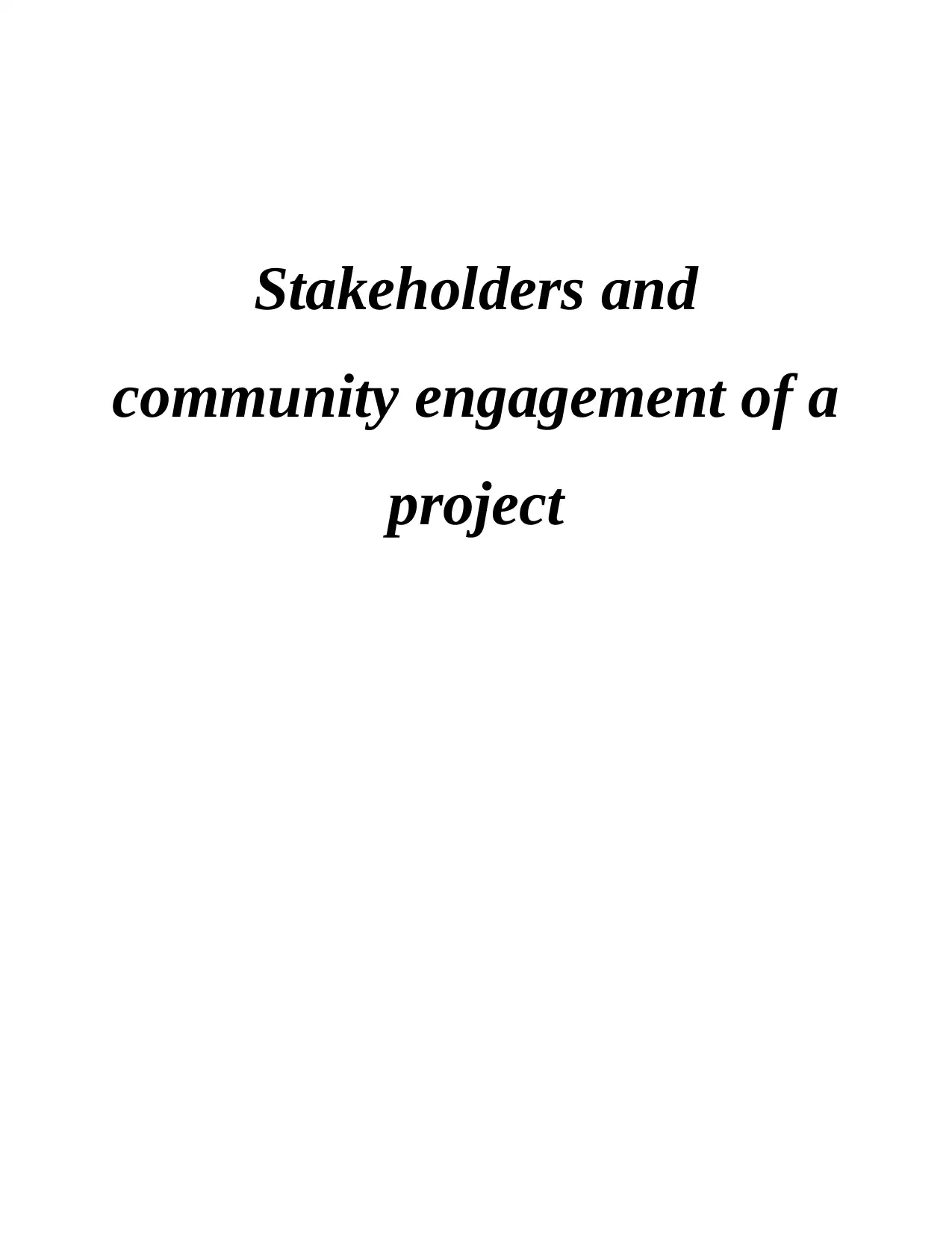
Stakeholders and
community engagement of a
project
community engagement of a
project
Paraphrase This Document
Need a fresh take? Get an instant paraphrase of this document with our AI Paraphraser
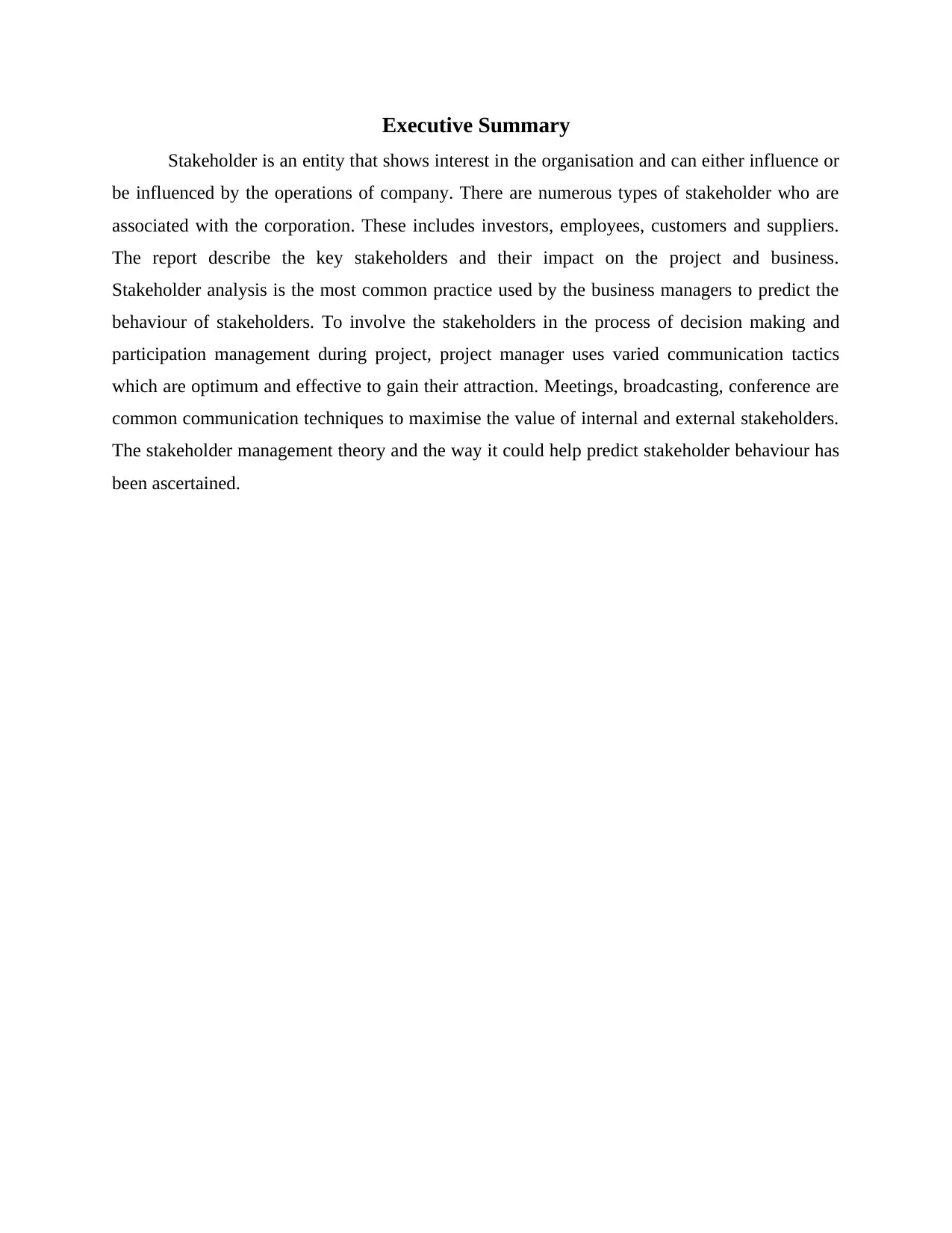
Executive Summary
Stakeholder is an entity that shows interest in the organisation and can either influence or
be influenced by the operations of company. There are numerous types of stakeholder who are
associated with the corporation. These includes investors, employees, customers and suppliers.
The report describe the key stakeholders and their impact on the project and business.
Stakeholder analysis is the most common practice used by the business managers to predict the
behaviour of stakeholders. To involve the stakeholders in the process of decision making and
participation management during project, project manager uses varied communication tactics
which are optimum and effective to gain their attraction. Meetings, broadcasting, conference are
common communication techniques to maximise the value of internal and external stakeholders.
The stakeholder management theory and the way it could help predict stakeholder behaviour has
been ascertained.
Stakeholder is an entity that shows interest in the organisation and can either influence or
be influenced by the operations of company. There are numerous types of stakeholder who are
associated with the corporation. These includes investors, employees, customers and suppliers.
The report describe the key stakeholders and their impact on the project and business.
Stakeholder analysis is the most common practice used by the business managers to predict the
behaviour of stakeholders. To involve the stakeholders in the process of decision making and
participation management during project, project manager uses varied communication tactics
which are optimum and effective to gain their attraction. Meetings, broadcasting, conference are
common communication techniques to maximise the value of internal and external stakeholders.
The stakeholder management theory and the way it could help predict stakeholder behaviour has
been ascertained.
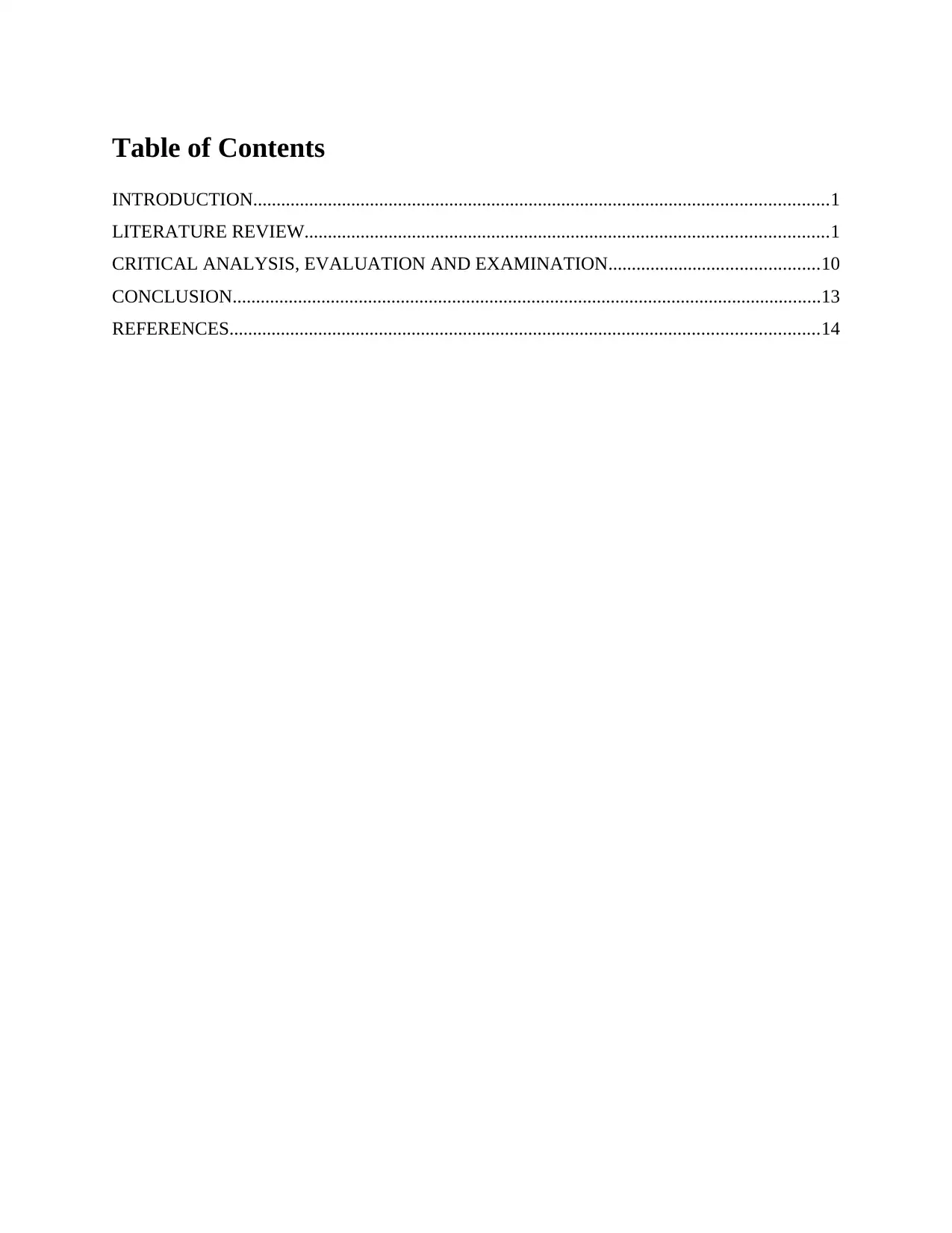
Table of Contents
INTRODUCTION...........................................................................................................................1
LITERATURE REVIEW................................................................................................................1
CRITICAL ANALYSIS, EVALUATION AND EXAMINATION.............................................10
CONCLUSION..............................................................................................................................13
REFERENCES..............................................................................................................................14
INTRODUCTION...........................................................................................................................1
LITERATURE REVIEW................................................................................................................1
CRITICAL ANALYSIS, EVALUATION AND EXAMINATION.............................................10
CONCLUSION..............................................................................................................................13
REFERENCES..............................................................................................................................14
⊘ This is a preview!⊘
Do you want full access?
Subscribe today to unlock all pages.

Trusted by 1+ million students worldwide
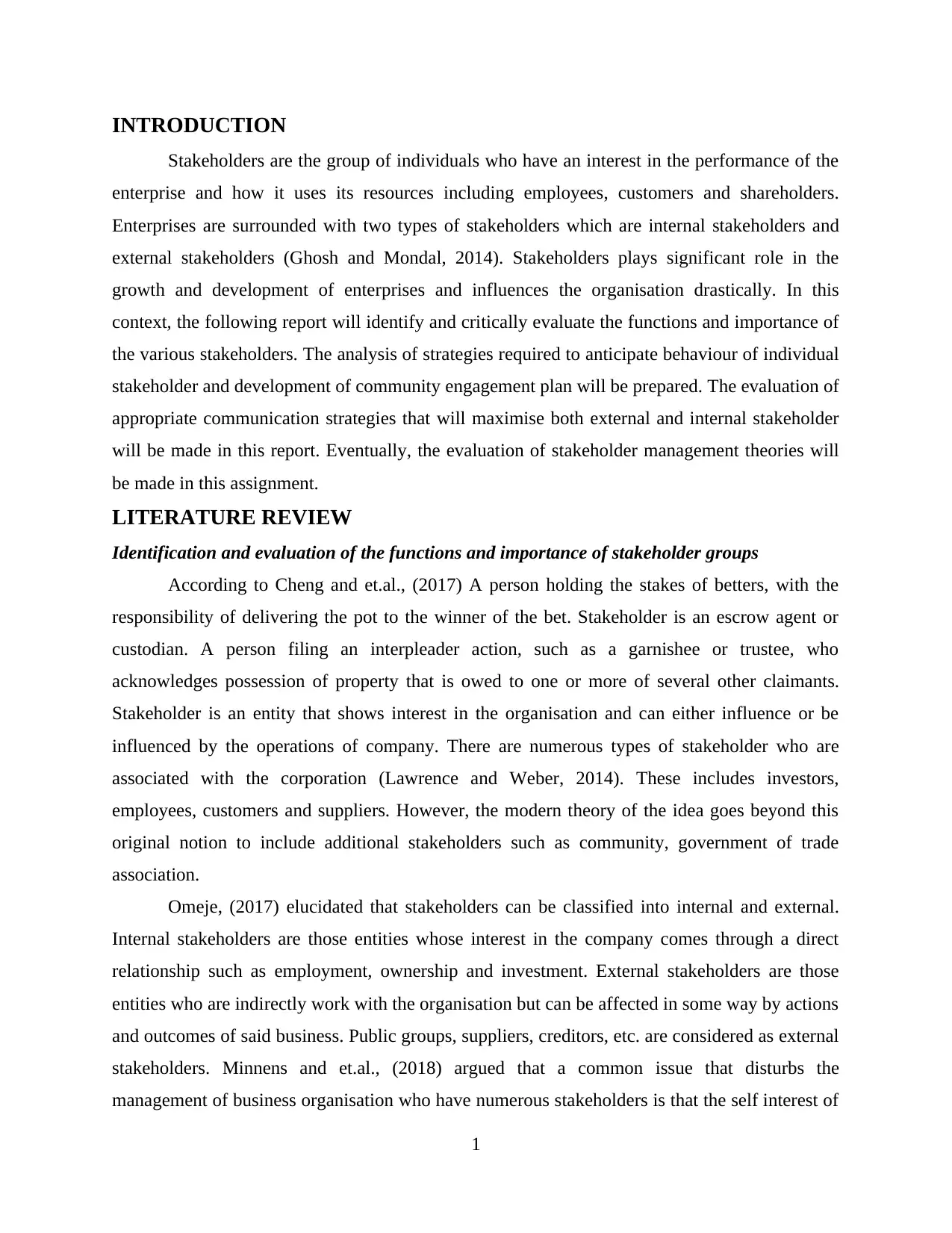
INTRODUCTION
Stakeholders are the group of individuals who have an interest in the performance of the
enterprise and how it uses its resources including employees, customers and shareholders.
Enterprises are surrounded with two types of stakeholders which are internal stakeholders and
external stakeholders (Ghosh and Mondal, 2014). Stakeholders plays significant role in the
growth and development of enterprises and influences the organisation drastically. In this
context, the following report will identify and critically evaluate the functions and importance of
the various stakeholders. The analysis of strategies required to anticipate behaviour of individual
stakeholder and development of community engagement plan will be prepared. The evaluation of
appropriate communication strategies that will maximise both external and internal stakeholder
will be made in this report. Eventually, the evaluation of stakeholder management theories will
be made in this assignment.
LITERATURE REVIEW
Identification and evaluation of the functions and importance of stakeholder groups
According to Cheng and et.al., (2017) A person holding the stakes of betters, with the
responsibility of delivering the pot to the winner of the bet. Stakeholder is an escrow agent or
custodian. A person filing an interpleader action, such as a garnishee or trustee, who
acknowledges possession of property that is owed to one or more of several other claimants.
Stakeholder is an entity that shows interest in the organisation and can either influence or be
influenced by the operations of company. There are numerous types of stakeholder who are
associated with the corporation (Lawrence and Weber, 2014). These includes investors,
employees, customers and suppliers. However, the modern theory of the idea goes beyond this
original notion to include additional stakeholders such as community, government of trade
association.
Omeje, (2017) elucidated that stakeholders can be classified into internal and external.
Internal stakeholders are those entities whose interest in the company comes through a direct
relationship such as employment, ownership and investment. External stakeholders are those
entities who are indirectly work with the organisation but can be affected in some way by actions
and outcomes of said business. Public groups, suppliers, creditors, etc. are considered as external
stakeholders. Minnens and et.al., (2018) argued that a common issue that disturbs the
management of business organisation who have numerous stakeholders is that the self interest of
1
Stakeholders are the group of individuals who have an interest in the performance of the
enterprise and how it uses its resources including employees, customers and shareholders.
Enterprises are surrounded with two types of stakeholders which are internal stakeholders and
external stakeholders (Ghosh and Mondal, 2014). Stakeholders plays significant role in the
growth and development of enterprises and influences the organisation drastically. In this
context, the following report will identify and critically evaluate the functions and importance of
the various stakeholders. The analysis of strategies required to anticipate behaviour of individual
stakeholder and development of community engagement plan will be prepared. The evaluation of
appropriate communication strategies that will maximise both external and internal stakeholder
will be made in this report. Eventually, the evaluation of stakeholder management theories will
be made in this assignment.
LITERATURE REVIEW
Identification and evaluation of the functions and importance of stakeholder groups
According to Cheng and et.al., (2017) A person holding the stakes of betters, with the
responsibility of delivering the pot to the winner of the bet. Stakeholder is an escrow agent or
custodian. A person filing an interpleader action, such as a garnishee or trustee, who
acknowledges possession of property that is owed to one or more of several other claimants.
Stakeholder is an entity that shows interest in the organisation and can either influence or be
influenced by the operations of company. There are numerous types of stakeholder who are
associated with the corporation (Lawrence and Weber, 2014). These includes investors,
employees, customers and suppliers. However, the modern theory of the idea goes beyond this
original notion to include additional stakeholders such as community, government of trade
association.
Omeje, (2017) elucidated that stakeholders can be classified into internal and external.
Internal stakeholders are those entities whose interest in the company comes through a direct
relationship such as employment, ownership and investment. External stakeholders are those
entities who are indirectly work with the organisation but can be affected in some way by actions
and outcomes of said business. Public groups, suppliers, creditors, etc. are considered as external
stakeholders. Minnens and et.al., (2018) argued that a common issue that disturbs the
management of business organisation who have numerous stakeholders is that the self interest of
1
Paraphrase This Document
Need a fresh take? Get an instant paraphrase of this document with our AI Paraphraser
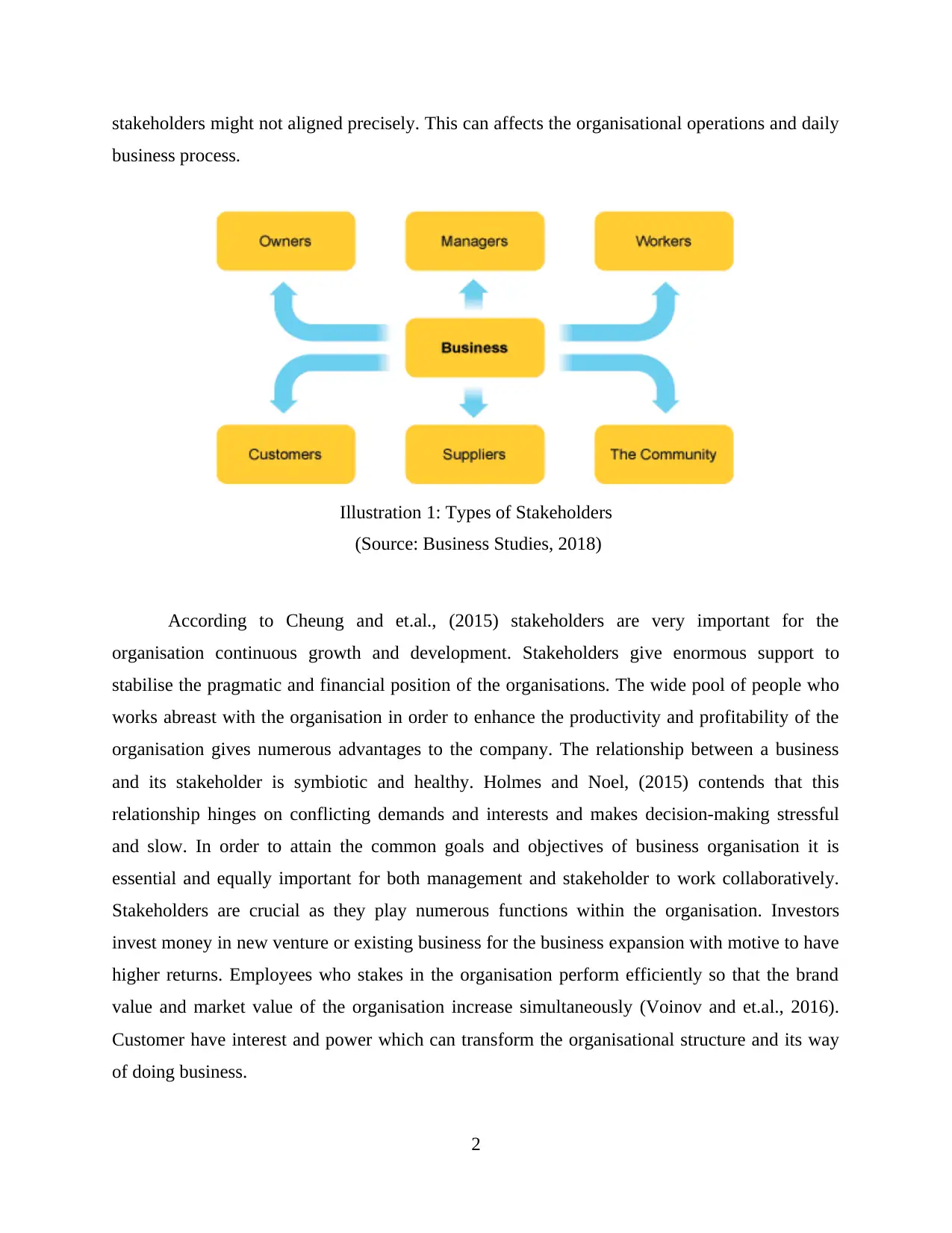
stakeholders might not aligned precisely. This can affects the organisational operations and daily
business process.
According to Cheung and et.al., (2015) stakeholders are very important for the
organisation continuous growth and development. Stakeholders give enormous support to
stabilise the pragmatic and financial position of the organisations. The wide pool of people who
works abreast with the organisation in order to enhance the productivity and profitability of the
organisation gives numerous advantages to the company. The relationship between a business
and its stakeholder is symbiotic and healthy. Holmes and Noel, (2015) contends that this
relationship hinges on conflicting demands and interests and makes decision-making stressful
and slow. In order to attain the common goals and objectives of business organisation it is
essential and equally important for both management and stakeholder to work collaboratively.
Stakeholders are crucial as they play numerous functions within the organisation. Investors
invest money in new venture or existing business for the business expansion with motive to have
higher returns. Employees who stakes in the organisation perform efficiently so that the brand
value and market value of the organisation increase simultaneously (Voinov and et.al., 2016).
Customer have interest and power which can transform the organisational structure and its way
of doing business.
2
Illustration 1: Types of Stakeholders
(Source: Business Studies, 2018)
business process.
According to Cheung and et.al., (2015) stakeholders are very important for the
organisation continuous growth and development. Stakeholders give enormous support to
stabilise the pragmatic and financial position of the organisations. The wide pool of people who
works abreast with the organisation in order to enhance the productivity and profitability of the
organisation gives numerous advantages to the company. The relationship between a business
and its stakeholder is symbiotic and healthy. Holmes and Noel, (2015) contends that this
relationship hinges on conflicting demands and interests and makes decision-making stressful
and slow. In order to attain the common goals and objectives of business organisation it is
essential and equally important for both management and stakeholder to work collaboratively.
Stakeholders are crucial as they play numerous functions within the organisation. Investors
invest money in new venture or existing business for the business expansion with motive to have
higher returns. Employees who stakes in the organisation perform efficiently so that the brand
value and market value of the organisation increase simultaneously (Voinov and et.al., 2016).
Customer have interest and power which can transform the organisational structure and its way
of doing business.
2
Illustration 1: Types of Stakeholders
(Source: Business Studies, 2018)
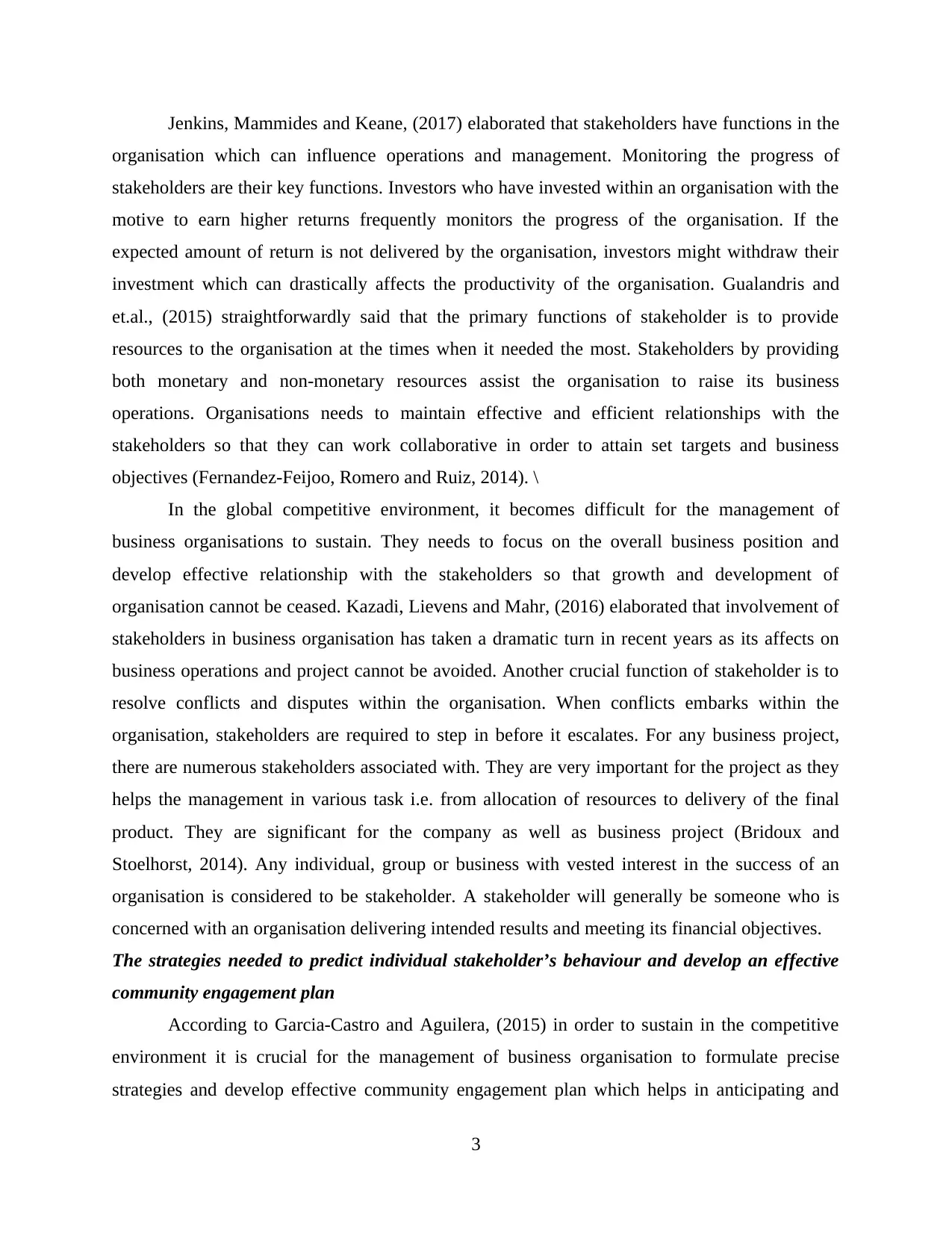
Jenkins, Mammides and Keane, (2017) elaborated that stakeholders have functions in the
organisation which can influence operations and management. Monitoring the progress of
stakeholders are their key functions. Investors who have invested within an organisation with the
motive to earn higher returns frequently monitors the progress of the organisation. If the
expected amount of return is not delivered by the organisation, investors might withdraw their
investment which can drastically affects the productivity of the organisation. Gualandris and
et.al., (2015) straightforwardly said that the primary functions of stakeholder is to provide
resources to the organisation at the times when it needed the most. Stakeholders by providing
both monetary and non-monetary resources assist the organisation to raise its business
operations. Organisations needs to maintain effective and efficient relationships with the
stakeholders so that they can work collaborative in order to attain set targets and business
objectives (Fernandez-Feijoo, Romero and Ruiz, 2014). \
In the global competitive environment, it becomes difficult for the management of
business organisations to sustain. They needs to focus on the overall business position and
develop effective relationship with the stakeholders so that growth and development of
organisation cannot be ceased. Kazadi, Lievens and Mahr, (2016) elaborated that involvement of
stakeholders in business organisation has taken a dramatic turn in recent years as its affects on
business operations and project cannot be avoided. Another crucial function of stakeholder is to
resolve conflicts and disputes within the organisation. When conflicts embarks within the
organisation, stakeholders are required to step in before it escalates. For any business project,
there are numerous stakeholders associated with. They are very important for the project as they
helps the management in various task i.e. from allocation of resources to delivery of the final
product. They are significant for the company as well as business project (Bridoux and
Stoelhorst, 2014). Any individual, group or business with vested interest in the success of an
organisation is considered to be stakeholder. A stakeholder will generally be someone who is
concerned with an organisation delivering intended results and meeting its financial objectives.
The strategies needed to predict individual stakeholder’s behaviour and develop an effective
community engagement plan
According to Garcia-Castro and Aguilera, (2015) in order to sustain in the competitive
environment it is crucial for the management of business organisation to formulate precise
strategies and develop effective community engagement plan which helps in anticipating and
3
organisation which can influence operations and management. Monitoring the progress of
stakeholders are their key functions. Investors who have invested within an organisation with the
motive to earn higher returns frequently monitors the progress of the organisation. If the
expected amount of return is not delivered by the organisation, investors might withdraw their
investment which can drastically affects the productivity of the organisation. Gualandris and
et.al., (2015) straightforwardly said that the primary functions of stakeholder is to provide
resources to the organisation at the times when it needed the most. Stakeholders by providing
both monetary and non-monetary resources assist the organisation to raise its business
operations. Organisations needs to maintain effective and efficient relationships with the
stakeholders so that they can work collaborative in order to attain set targets and business
objectives (Fernandez-Feijoo, Romero and Ruiz, 2014). \
In the global competitive environment, it becomes difficult for the management of
business organisations to sustain. They needs to focus on the overall business position and
develop effective relationship with the stakeholders so that growth and development of
organisation cannot be ceased. Kazadi, Lievens and Mahr, (2016) elaborated that involvement of
stakeholders in business organisation has taken a dramatic turn in recent years as its affects on
business operations and project cannot be avoided. Another crucial function of stakeholder is to
resolve conflicts and disputes within the organisation. When conflicts embarks within the
organisation, stakeholders are required to step in before it escalates. For any business project,
there are numerous stakeholders associated with. They are very important for the project as they
helps the management in various task i.e. from allocation of resources to delivery of the final
product. They are significant for the company as well as business project (Bridoux and
Stoelhorst, 2014). Any individual, group or business with vested interest in the success of an
organisation is considered to be stakeholder. A stakeholder will generally be someone who is
concerned with an organisation delivering intended results and meeting its financial objectives.
The strategies needed to predict individual stakeholder’s behaviour and develop an effective
community engagement plan
According to Garcia-Castro and Aguilera, (2015) in order to sustain in the competitive
environment it is crucial for the management of business organisation to formulate precise
strategies and develop effective community engagement plan which helps in anticipating and
3
⊘ This is a preview!⊘
Do you want full access?
Subscribe today to unlock all pages.

Trusted by 1+ million students worldwide
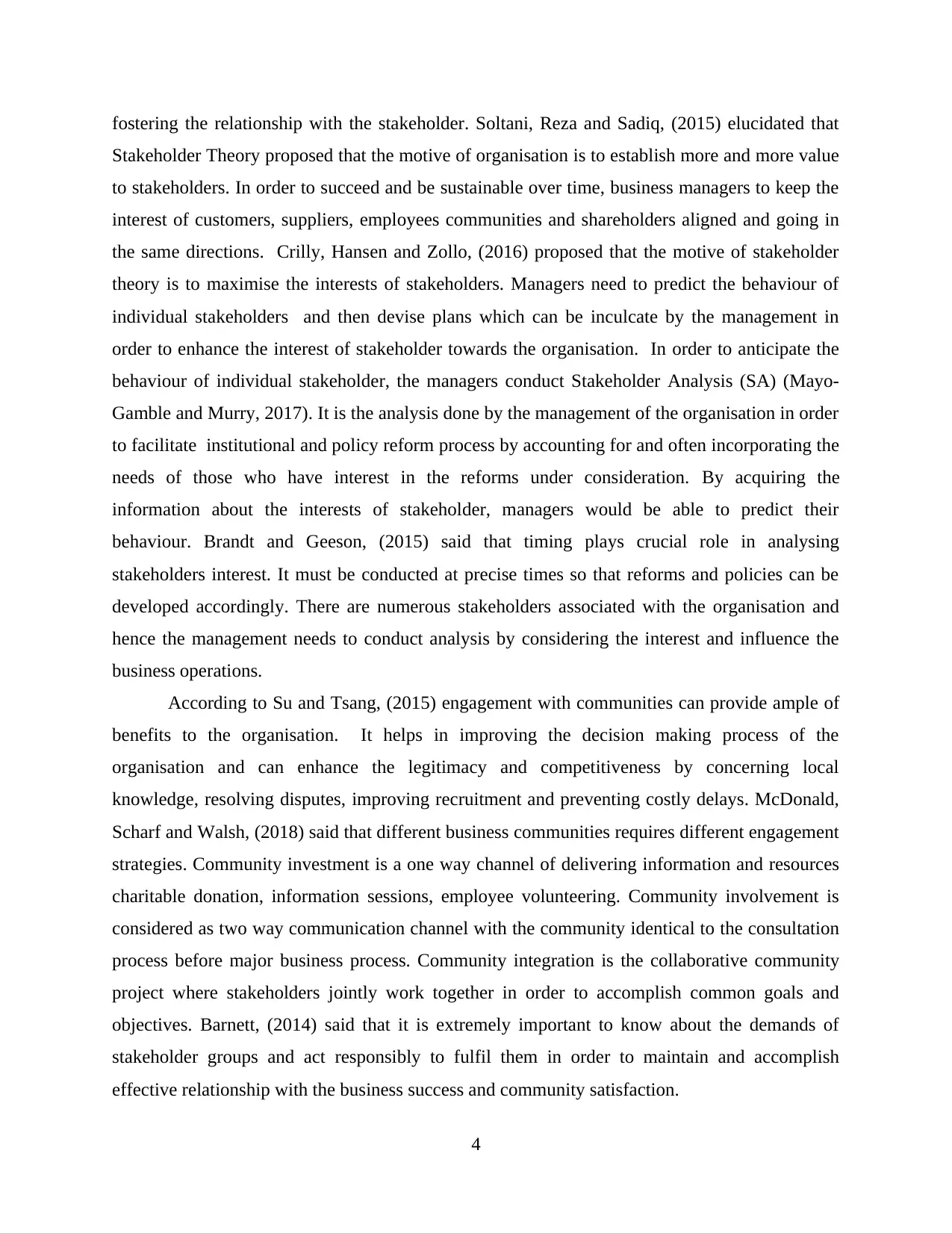
fostering the relationship with the stakeholder. Soltani, Reza and Sadiq, (2015) elucidated that
Stakeholder Theory proposed that the motive of organisation is to establish more and more value
to stakeholders. In order to succeed and be sustainable over time, business managers to keep the
interest of customers, suppliers, employees communities and shareholders aligned and going in
the same directions. Crilly, Hansen and Zollo, (2016) proposed that the motive of stakeholder
theory is to maximise the interests of stakeholders. Managers need to predict the behaviour of
individual stakeholders and then devise plans which can be inculcate by the management in
order to enhance the interest of stakeholder towards the organisation. In order to anticipate the
behaviour of individual stakeholder, the managers conduct Stakeholder Analysis (SA) (Mayo-
Gamble and Murry, 2017). It is the analysis done by the management of the organisation in order
to facilitate institutional and policy reform process by accounting for and often incorporating the
needs of those who have interest in the reforms under consideration. By acquiring the
information about the interests of stakeholder, managers would be able to predict their
behaviour. Brandt and Geeson, (2015) said that timing plays crucial role in analysing
stakeholders interest. It must be conducted at precise times so that reforms and policies can be
developed accordingly. There are numerous stakeholders associated with the organisation and
hence the management needs to conduct analysis by considering the interest and influence the
business operations.
According to Su and Tsang, (2015) engagement with communities can provide ample of
benefits to the organisation. It helps in improving the decision making process of the
organisation and can enhance the legitimacy and competitiveness by concerning local
knowledge, resolving disputes, improving recruitment and preventing costly delays. McDonald,
Scharf and Walsh, (2018) said that different business communities requires different engagement
strategies. Community investment is a one way channel of delivering information and resources
charitable donation, information sessions, employee volunteering. Community involvement is
considered as two way communication channel with the community identical to the consultation
process before major business process. Community integration is the collaborative community
project where stakeholders jointly work together in order to accomplish common goals and
objectives. Barnett, (2014) said that it is extremely important to know about the demands of
stakeholder groups and act responsibly to fulfil them in order to maintain and accomplish
effective relationship with the business success and community satisfaction.
4
Stakeholder Theory proposed that the motive of organisation is to establish more and more value
to stakeholders. In order to succeed and be sustainable over time, business managers to keep the
interest of customers, suppliers, employees communities and shareholders aligned and going in
the same directions. Crilly, Hansen and Zollo, (2016) proposed that the motive of stakeholder
theory is to maximise the interests of stakeholders. Managers need to predict the behaviour of
individual stakeholders and then devise plans which can be inculcate by the management in
order to enhance the interest of stakeholder towards the organisation. In order to anticipate the
behaviour of individual stakeholder, the managers conduct Stakeholder Analysis (SA) (Mayo-
Gamble and Murry, 2017). It is the analysis done by the management of the organisation in order
to facilitate institutional and policy reform process by accounting for and often incorporating the
needs of those who have interest in the reforms under consideration. By acquiring the
information about the interests of stakeholder, managers would be able to predict their
behaviour. Brandt and Geeson, (2015) said that timing plays crucial role in analysing
stakeholders interest. It must be conducted at precise times so that reforms and policies can be
developed accordingly. There are numerous stakeholders associated with the organisation and
hence the management needs to conduct analysis by considering the interest and influence the
business operations.
According to Su and Tsang, (2015) engagement with communities can provide ample of
benefits to the organisation. It helps in improving the decision making process of the
organisation and can enhance the legitimacy and competitiveness by concerning local
knowledge, resolving disputes, improving recruitment and preventing costly delays. McDonald,
Scharf and Walsh, (2018) said that different business communities requires different engagement
strategies. Community investment is a one way channel of delivering information and resources
charitable donation, information sessions, employee volunteering. Community involvement is
considered as two way communication channel with the community identical to the consultation
process before major business process. Community integration is the collaborative community
project where stakeholders jointly work together in order to accomplish common goals and
objectives. Barnett, (2014) said that it is extremely important to know about the demands of
stakeholder groups and act responsibly to fulfil them in order to maintain and accomplish
effective relationship with the business success and community satisfaction.
4
Paraphrase This Document
Need a fresh take? Get an instant paraphrase of this document with our AI Paraphraser
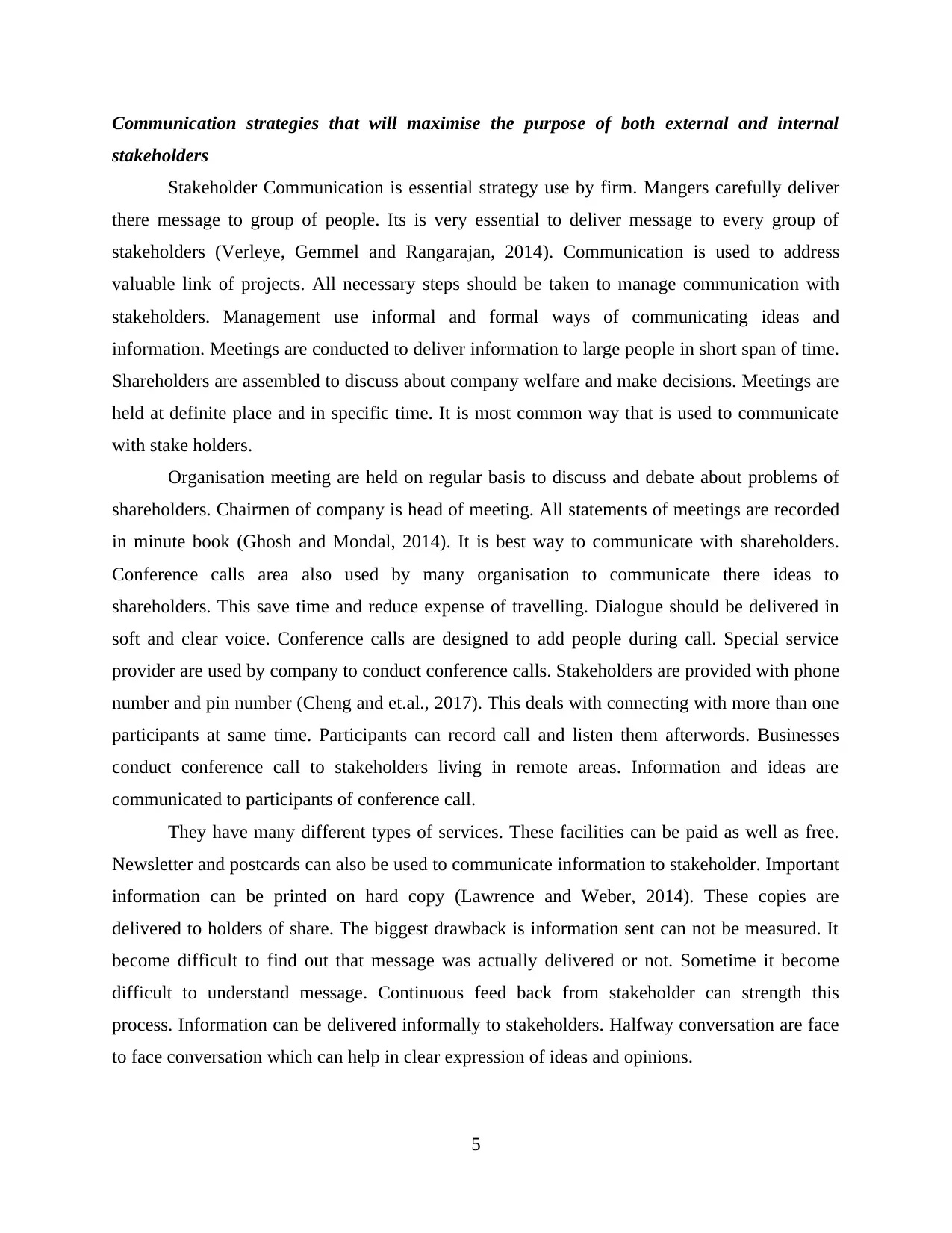
Communication strategies that will maximise the purpose of both external and internal
stakeholders
Stakeholder Communication is essential strategy use by firm. Mangers carefully deliver
there message to group of people. Its is very essential to deliver message to every group of
stakeholders (Verleye, Gemmel and Rangarajan, 2014). Communication is used to address
valuable link of projects. All necessary steps should be taken to manage communication with
stakeholders. Management use informal and formal ways of communicating ideas and
information. Meetings are conducted to deliver information to large people in short span of time.
Shareholders are assembled to discuss about company welfare and make decisions. Meetings are
held at definite place and in specific time. It is most common way that is used to communicate
with stake holders.
Organisation meeting are held on regular basis to discuss and debate about problems of
shareholders. Chairmen of company is head of meeting. All statements of meetings are recorded
in minute book (Ghosh and Mondal, 2014). It is best way to communicate with shareholders.
Conference calls area also used by many organisation to communicate there ideas to
shareholders. This save time and reduce expense of travelling. Dialogue should be delivered in
soft and clear voice. Conference calls are designed to add people during call. Special service
provider are used by company to conduct conference calls. Stakeholders are provided with phone
number and pin number (Cheng and et.al., 2017). This deals with connecting with more than one
participants at same time. Participants can record call and listen them afterwords. Businesses
conduct conference call to stakeholders living in remote areas. Information and ideas are
communicated to participants of conference call.
They have many different types of services. These facilities can be paid as well as free.
Newsletter and postcards can also be used to communicate information to stakeholder. Important
information can be printed on hard copy (Lawrence and Weber, 2014). These copies are
delivered to holders of share. The biggest drawback is information sent can not be measured. It
become difficult to find out that message was actually delivered or not. Sometime it become
difficult to understand message. Continuous feed back from stakeholder can strength this
process. Information can be delivered informally to stakeholders. Halfway conversation are face
to face conversation which can help in clear expression of ideas and opinions.
5
stakeholders
Stakeholder Communication is essential strategy use by firm. Mangers carefully deliver
there message to group of people. Its is very essential to deliver message to every group of
stakeholders (Verleye, Gemmel and Rangarajan, 2014). Communication is used to address
valuable link of projects. All necessary steps should be taken to manage communication with
stakeholders. Management use informal and formal ways of communicating ideas and
information. Meetings are conducted to deliver information to large people in short span of time.
Shareholders are assembled to discuss about company welfare and make decisions. Meetings are
held at definite place and in specific time. It is most common way that is used to communicate
with stake holders.
Organisation meeting are held on regular basis to discuss and debate about problems of
shareholders. Chairmen of company is head of meeting. All statements of meetings are recorded
in minute book (Ghosh and Mondal, 2014). It is best way to communicate with shareholders.
Conference calls area also used by many organisation to communicate there ideas to
shareholders. This save time and reduce expense of travelling. Dialogue should be delivered in
soft and clear voice. Conference calls are designed to add people during call. Special service
provider are used by company to conduct conference calls. Stakeholders are provided with phone
number and pin number (Cheng and et.al., 2017). This deals with connecting with more than one
participants at same time. Participants can record call and listen them afterwords. Businesses
conduct conference call to stakeholders living in remote areas. Information and ideas are
communicated to participants of conference call.
They have many different types of services. These facilities can be paid as well as free.
Newsletter and postcards can also be used to communicate information to stakeholder. Important
information can be printed on hard copy (Lawrence and Weber, 2014). These copies are
delivered to holders of share. The biggest drawback is information sent can not be measured. It
become difficult to find out that message was actually delivered or not. Sometime it become
difficult to understand message. Continuous feed back from stakeholder can strength this
process. Information can be delivered informally to stakeholders. Halfway conversation are face
to face conversation which can help in clear expression of ideas and opinions.
5
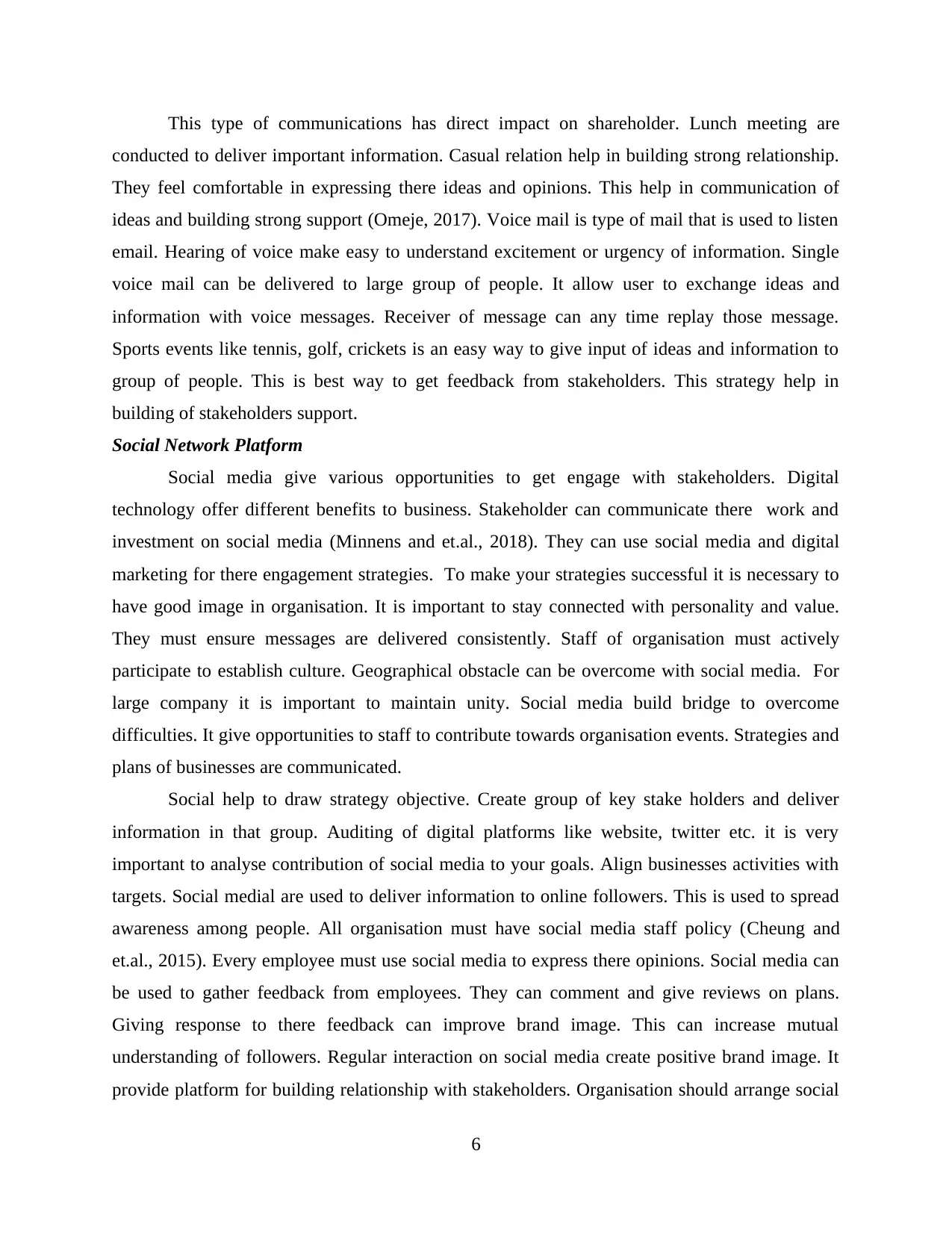
This type of communications has direct impact on shareholder. Lunch meeting are
conducted to deliver important information. Casual relation help in building strong relationship.
They feel comfortable in expressing there ideas and opinions. This help in communication of
ideas and building strong support (Omeje, 2017). Voice mail is type of mail that is used to listen
email. Hearing of voice make easy to understand excitement or urgency of information. Single
voice mail can be delivered to large group of people. It allow user to exchange ideas and
information with voice messages. Receiver of message can any time replay those message.
Sports events like tennis, golf, crickets is an easy way to give input of ideas and information to
group of people. This is best way to get feedback from stakeholders. This strategy help in
building of stakeholders support.
Social Network Platform
Social media give various opportunities to get engage with stakeholders. Digital
technology offer different benefits to business. Stakeholder can communicate there work and
investment on social media (Minnens and et.al., 2018). They can use social media and digital
marketing for there engagement strategies. To make your strategies successful it is necessary to
have good image in organisation. It is important to stay connected with personality and value.
They must ensure messages are delivered consistently. Staff of organisation must actively
participate to establish culture. Geographical obstacle can be overcome with social media. For
large company it is important to maintain unity. Social media build bridge to overcome
difficulties. It give opportunities to staff to contribute towards organisation events. Strategies and
plans of businesses are communicated.
Social help to draw strategy objective. Create group of key stake holders and deliver
information in that group. Auditing of digital platforms like website, twitter etc. it is very
important to analyse contribution of social media to your goals. Align businesses activities with
targets. Social medial are used to deliver information to online followers. This is used to spread
awareness among people. All organisation must have social media staff policy (Cheung and
et.al., 2015). Every employee must use social media to express there opinions. Social media can
be used to gather feedback from employees. They can comment and give reviews on plans.
Giving response to there feedback can improve brand image. This can increase mutual
understanding of followers. Regular interaction on social media create positive brand image. It
provide platform for building relationship with stakeholders. Organisation should arrange social
6
conducted to deliver important information. Casual relation help in building strong relationship.
They feel comfortable in expressing there ideas and opinions. This help in communication of
ideas and building strong support (Omeje, 2017). Voice mail is type of mail that is used to listen
email. Hearing of voice make easy to understand excitement or urgency of information. Single
voice mail can be delivered to large group of people. It allow user to exchange ideas and
information with voice messages. Receiver of message can any time replay those message.
Sports events like tennis, golf, crickets is an easy way to give input of ideas and information to
group of people. This is best way to get feedback from stakeholders. This strategy help in
building of stakeholders support.
Social Network Platform
Social media give various opportunities to get engage with stakeholders. Digital
technology offer different benefits to business. Stakeholder can communicate there work and
investment on social media (Minnens and et.al., 2018). They can use social media and digital
marketing for there engagement strategies. To make your strategies successful it is necessary to
have good image in organisation. It is important to stay connected with personality and value.
They must ensure messages are delivered consistently. Staff of organisation must actively
participate to establish culture. Geographical obstacle can be overcome with social media. For
large company it is important to maintain unity. Social media build bridge to overcome
difficulties. It give opportunities to staff to contribute towards organisation events. Strategies and
plans of businesses are communicated.
Social help to draw strategy objective. Create group of key stake holders and deliver
information in that group. Auditing of digital platforms like website, twitter etc. it is very
important to analyse contribution of social media to your goals. Align businesses activities with
targets. Social medial are used to deliver information to online followers. This is used to spread
awareness among people. All organisation must have social media staff policy (Cheung and
et.al., 2015). Every employee must use social media to express there opinions. Social media can
be used to gather feedback from employees. They can comment and give reviews on plans.
Giving response to there feedback can improve brand image. This can increase mutual
understanding of followers. Regular interaction on social media create positive brand image. It
provide platform for building relationship with stakeholders. Organisation should arrange social
6
⊘ This is a preview!⊘
Do you want full access?
Subscribe today to unlock all pages.

Trusted by 1+ million students worldwide
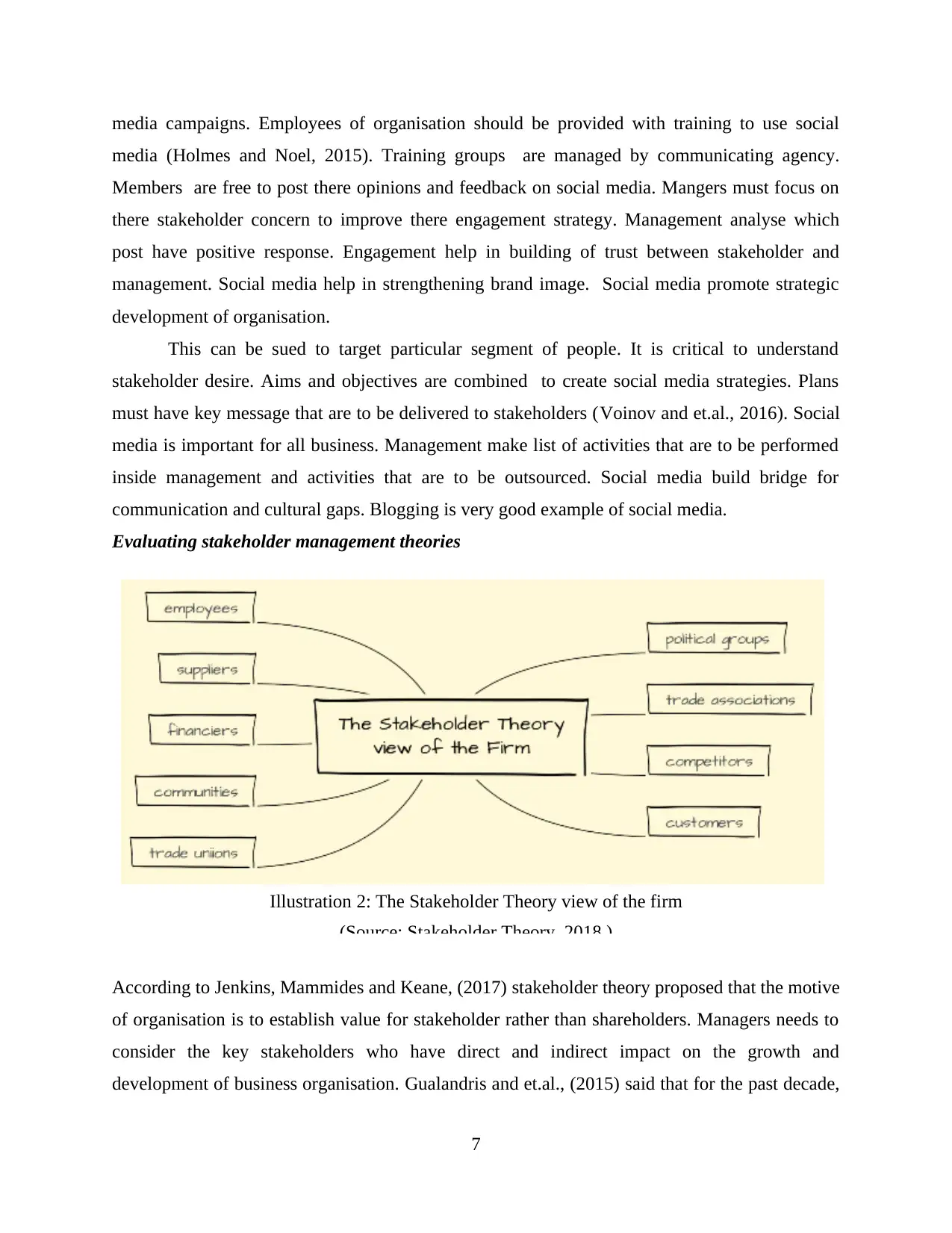
media campaigns. Employees of organisation should be provided with training to use social
media (Holmes and Noel, 2015). Training groups are managed by communicating agency.
Members are free to post there opinions and feedback on social media. Mangers must focus on
there stakeholder concern to improve there engagement strategy. Management analyse which
post have positive response. Engagement help in building of trust between stakeholder and
management. Social media help in strengthening brand image. Social media promote strategic
development of organisation.
This can be sued to target particular segment of people. It is critical to understand
stakeholder desire. Aims and objectives are combined to create social media strategies. Plans
must have key message that are to be delivered to stakeholders (Voinov and et.al., 2016). Social
media is important for all business. Management make list of activities that are to be performed
inside management and activities that are to be outsourced. Social media build bridge for
communication and cultural gaps. Blogging is very good example of social media.
Evaluating stakeholder management theories
According to Jenkins, Mammides and Keane, (2017) stakeholder theory proposed that the motive
of organisation is to establish value for stakeholder rather than shareholders. Managers needs to
consider the key stakeholders who have direct and indirect impact on the growth and
development of business organisation. Gualandris and et.al., (2015) said that for the past decade,
7
Illustration 2: The Stakeholder Theory view of the firm
(Source: Stakeholder Theory, 2018 )
media (Holmes and Noel, 2015). Training groups are managed by communicating agency.
Members are free to post there opinions and feedback on social media. Mangers must focus on
there stakeholder concern to improve there engagement strategy. Management analyse which
post have positive response. Engagement help in building of trust between stakeholder and
management. Social media help in strengthening brand image. Social media promote strategic
development of organisation.
This can be sued to target particular segment of people. It is critical to understand
stakeholder desire. Aims and objectives are combined to create social media strategies. Plans
must have key message that are to be delivered to stakeholders (Voinov and et.al., 2016). Social
media is important for all business. Management make list of activities that are to be performed
inside management and activities that are to be outsourced. Social media build bridge for
communication and cultural gaps. Blogging is very good example of social media.
Evaluating stakeholder management theories
According to Jenkins, Mammides and Keane, (2017) stakeholder theory proposed that the motive
of organisation is to establish value for stakeholder rather than shareholders. Managers needs to
consider the key stakeholders who have direct and indirect impact on the growth and
development of business organisation. Gualandris and et.al., (2015) said that for the past decade,
7
Illustration 2: The Stakeholder Theory view of the firm
(Source: Stakeholder Theory, 2018 )
Paraphrase This Document
Need a fresh take? Get an instant paraphrase of this document with our AI Paraphraser
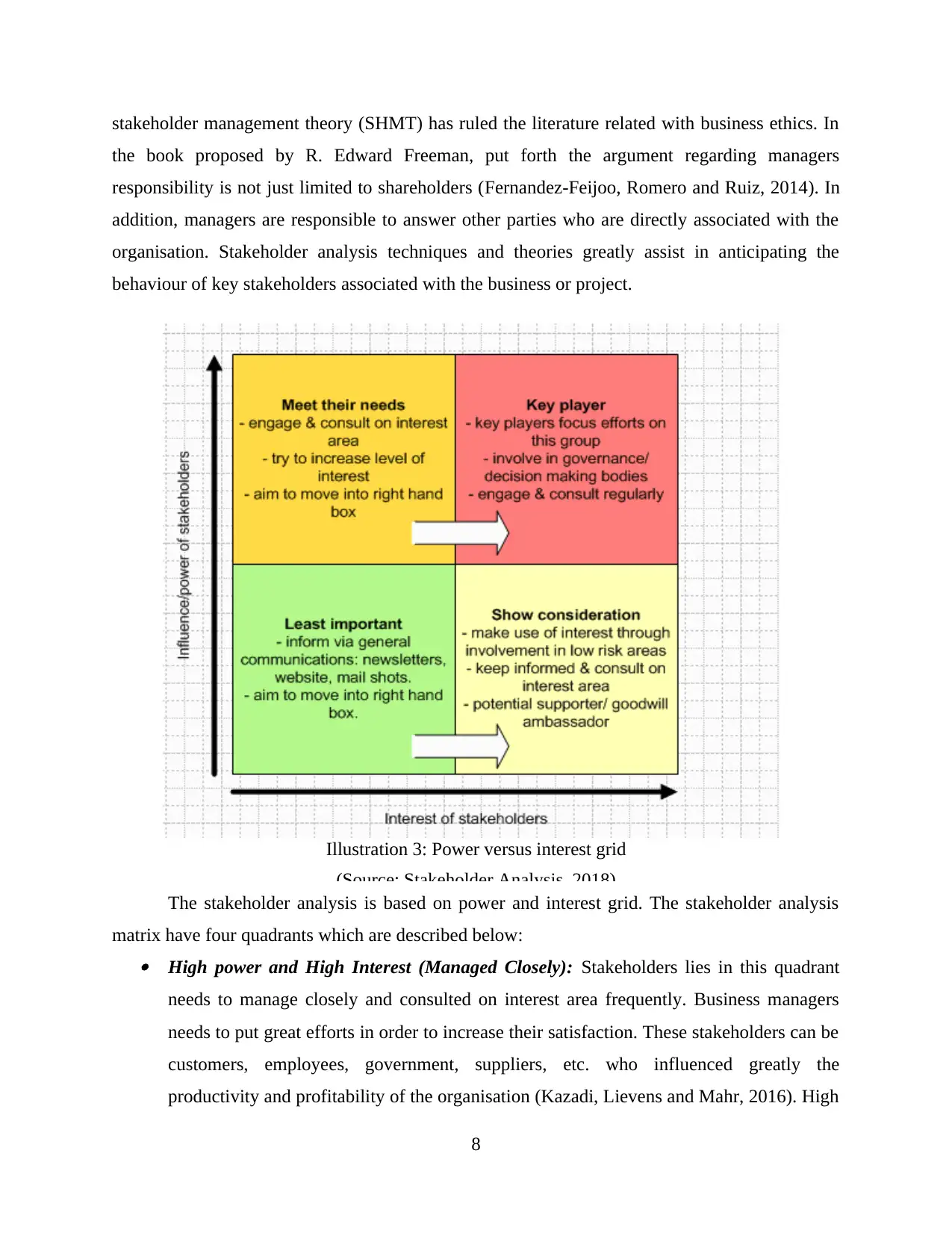
stakeholder management theory (SHMT) has ruled the literature related with business ethics. In
the book proposed by R. Edward Freeman, put forth the argument regarding managers
responsibility is not just limited to shareholders (Fernandez-Feijoo, Romero and Ruiz, 2014). In
addition, managers are responsible to answer other parties who are directly associated with the
organisation. Stakeholder analysis techniques and theories greatly assist in anticipating the
behaviour of key stakeholders associated with the business or project.
The stakeholder analysis is based on power and interest grid. The stakeholder analysis
matrix have four quadrants which are described below: High power and High Interest (Managed Closely): Stakeholders lies in this quadrant
needs to manage closely and consulted on interest area frequently. Business managers
needs to put great efforts in order to increase their satisfaction. These stakeholders can be
customers, employees, government, suppliers, etc. who influenced greatly the
productivity and profitability of the organisation (Kazadi, Lievens and Mahr, 2016). High
8
Illustration 3: Power versus interest grid
(Source: Stakeholder Analysis, 2018)
the book proposed by R. Edward Freeman, put forth the argument regarding managers
responsibility is not just limited to shareholders (Fernandez-Feijoo, Romero and Ruiz, 2014). In
addition, managers are responsible to answer other parties who are directly associated with the
organisation. Stakeholder analysis techniques and theories greatly assist in anticipating the
behaviour of key stakeholders associated with the business or project.
The stakeholder analysis is based on power and interest grid. The stakeholder analysis
matrix have four quadrants which are described below: High power and High Interest (Managed Closely): Stakeholders lies in this quadrant
needs to manage closely and consulted on interest area frequently. Business managers
needs to put great efforts in order to increase their satisfaction. These stakeholders can be
customers, employees, government, suppliers, etc. who influenced greatly the
productivity and profitability of the organisation (Kazadi, Lievens and Mahr, 2016). High
8
Illustration 3: Power versus interest grid
(Source: Stakeholder Analysis, 2018)
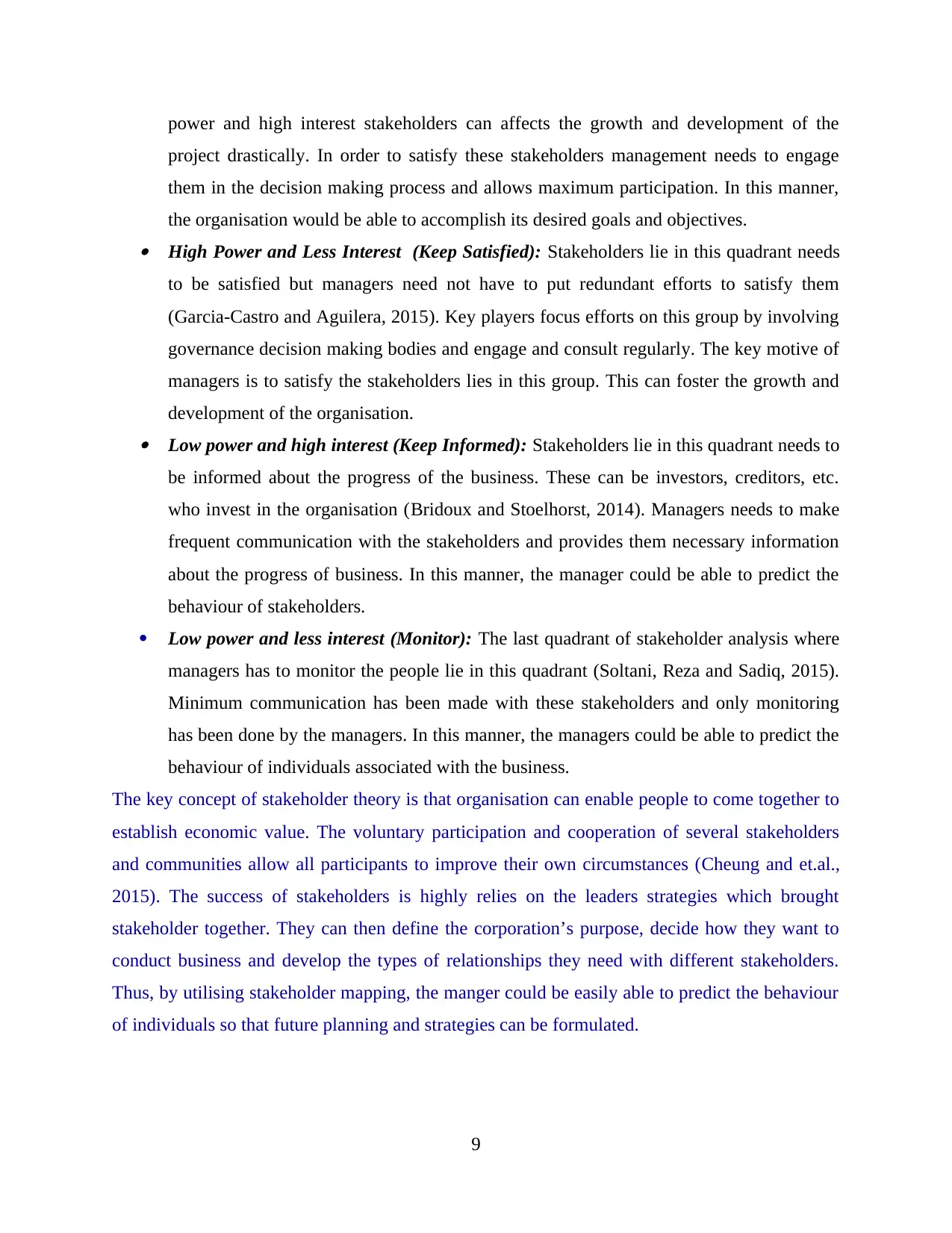
power and high interest stakeholders can affects the growth and development of the
project drastically. In order to satisfy these stakeholders management needs to engage
them in the decision making process and allows maximum participation. In this manner,
the organisation would be able to accomplish its desired goals and objectives. High Power and Less Interest (Keep Satisfied): Stakeholders lie in this quadrant needs
to be satisfied but managers need not have to put redundant efforts to satisfy them
(Garcia-Castro and Aguilera, 2015). Key players focus efforts on this group by involving
governance decision making bodies and engage and consult regularly. The key motive of
managers is to satisfy the stakeholders lies in this group. This can foster the growth and
development of the organisation. Low power and high interest (Keep Informed): Stakeholders lie in this quadrant needs to
be informed about the progress of the business. These can be investors, creditors, etc.
who invest in the organisation (Bridoux and Stoelhorst, 2014). Managers needs to make
frequent communication with the stakeholders and provides them necessary information
about the progress of business. In this manner, the manager could be able to predict the
behaviour of stakeholders.
Low power and less interest (Monitor): The last quadrant of stakeholder analysis where
managers has to monitor the people lie in this quadrant (Soltani, Reza and Sadiq, 2015).
Minimum communication has been made with these stakeholders and only monitoring
has been done by the managers. In this manner, the managers could be able to predict the
behaviour of individuals associated with the business.
The key concept of stakeholder theory is that organisation can enable people to come together to
establish economic value. The voluntary participation and cooperation of several stakeholders
and communities allow all participants to improve their own circumstances (Cheung and et.al.,
2015). The success of stakeholders is highly relies on the leaders strategies which brought
stakeholder together. They can then define the corporation’s purpose, decide how they want to
conduct business and develop the types of relationships they need with different stakeholders.
Thus, by utilising stakeholder mapping, the manger could be easily able to predict the behaviour
of individuals so that future planning and strategies can be formulated.
9
project drastically. In order to satisfy these stakeholders management needs to engage
them in the decision making process and allows maximum participation. In this manner,
the organisation would be able to accomplish its desired goals and objectives. High Power and Less Interest (Keep Satisfied): Stakeholders lie in this quadrant needs
to be satisfied but managers need not have to put redundant efforts to satisfy them
(Garcia-Castro and Aguilera, 2015). Key players focus efforts on this group by involving
governance decision making bodies and engage and consult regularly. The key motive of
managers is to satisfy the stakeholders lies in this group. This can foster the growth and
development of the organisation. Low power and high interest (Keep Informed): Stakeholders lie in this quadrant needs to
be informed about the progress of the business. These can be investors, creditors, etc.
who invest in the organisation (Bridoux and Stoelhorst, 2014). Managers needs to make
frequent communication with the stakeholders and provides them necessary information
about the progress of business. In this manner, the manager could be able to predict the
behaviour of stakeholders.
Low power and less interest (Monitor): The last quadrant of stakeholder analysis where
managers has to monitor the people lie in this quadrant (Soltani, Reza and Sadiq, 2015).
Minimum communication has been made with these stakeholders and only monitoring
has been done by the managers. In this manner, the managers could be able to predict the
behaviour of individuals associated with the business.
The key concept of stakeholder theory is that organisation can enable people to come together to
establish economic value. The voluntary participation and cooperation of several stakeholders
and communities allow all participants to improve their own circumstances (Cheung and et.al.,
2015). The success of stakeholders is highly relies on the leaders strategies which brought
stakeholder together. They can then define the corporation’s purpose, decide how they want to
conduct business and develop the types of relationships they need with different stakeholders.
Thus, by utilising stakeholder mapping, the manger could be easily able to predict the behaviour
of individuals so that future planning and strategies can be formulated.
9
⊘ This is a preview!⊘
Do you want full access?
Subscribe today to unlock all pages.

Trusted by 1+ million students worldwide
1 out of 18
Related Documents
Your All-in-One AI-Powered Toolkit for Academic Success.
+13062052269
info@desklib.com
Available 24*7 on WhatsApp / Email
![[object Object]](/_next/static/media/star-bottom.7253800d.svg)
Unlock your academic potential
Copyright © 2020–2025 A2Z Services. All Rights Reserved. Developed and managed by ZUCOL.





